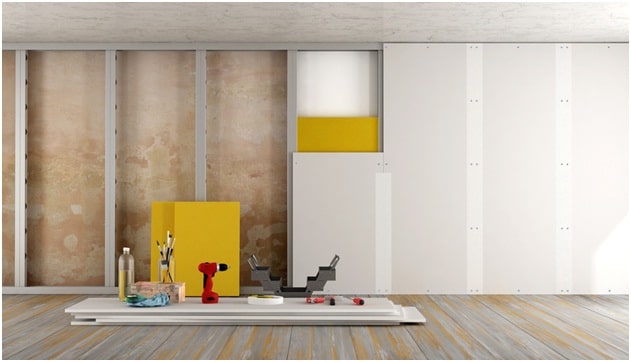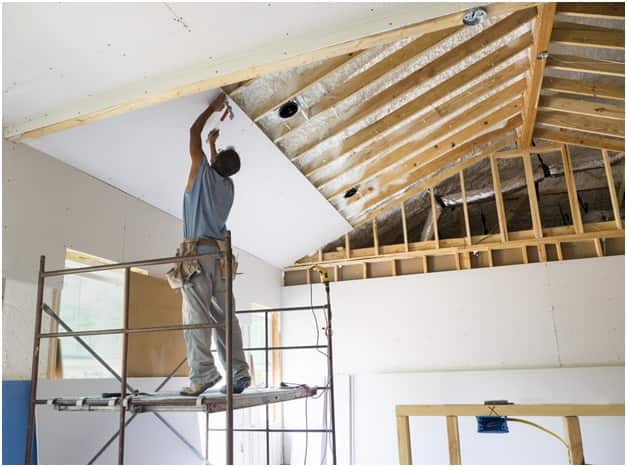
Globalization has led the world through many innovative strides across all industrial sectors.Construction is one of the primary industries that is booming since forever.The introduction of innovative technology and research has made it possible to construct buildings that were once imaginable but limited by execution and technology.

Innovations like computer-aided design, new construction materials and tools have collectively spearheaded the construction industry. It is especially true for the Indian subcontinent that is set to become the third largest construction market by 2025. India will be adding more than 11 million homes a year to become a $1 trillion industry.
With so many technological innovations, different building materials are surfacing that are improving the construction industry in every sense. However, the two building materials – fiberboard and drywall have revolutionized the construction industry while shaping the future of architecture.
1. Drywall
Drywall has been around in the construction business for more than seven decades. It is the preferred alternative for brick and mortar construction. It is easy-to-use and is less taxing on already scarce natural resources like water. Drywalls are made of thick fiber cement board and gypsum panels and offer similar strength as a brick wall. However, the difference lies in their ease of construction.
How are they shaping the future of architecture?
Drywalls are true to their name – they are walls that require no water during the construction process. Drywall construction is also four times faster than that of a brick wall. Not only this, drywall is six times lighter than a brick wall which makes constructing high rise buildings much easier. Transportation of material is also more straightforward and easier. Hard to reach places and tough terrains can easily make use of drywall construction. It is a win-win situation for architects, contractors and the end-customers.
For professionals who believe in delivering quality projects of architectural splendor, drywall can be work wonders. The smooth and crack-free surface of drywall makes it easier to paint while achieving superior results. For contractors, the wiring and maintenance before delivering a project are seamless too.
That is not all! Drywalls are also highly flexible – making them the ideal choice for modular spaces.From curvilinear to rectilinear spaces, your new interior designing project can be a pastiche of Japanese architecture with drywall.
2. Fiberboard
Fiberboard belongs to the same family of drywalls as far as construction is concerned. It is a generic name for construction panels made largely of wood, cement and vegetable fibers. Historically, wood has been the commonly used material in fiberboard. However, with the advancements in technology,other homogenous materials have replaced wood.
Today, some manufacturers use fiber boards made with cement and call it as fiber cement board. The board is an amalgamation of other materials like silica and cellulose fiber along with cement to give it desired properties like water and termite resistance.
How are they shaping the future of architecture?
Fiberboard or now called fiber cement board makes the construction process easier and faster which in turn helps to save costs on labor. It ensures timely delivery of projects, which translates to higher revenue for contractors. They can complete more projects in a month by using fiberboard; than they would if they were using brick and mortar for construction.
Different manufacturers use a combination of materials to make fiber boards that are suited for various needs. SCG Smart board is a world-renowned manufacturer of fiber cement board that is made with Silica, SCG Portland Cement, and special cellulose derived from autoclave process. Fiber boards from SCG Smart board are suited for both internal and external applications of flooring, ceilings and walls.
Fiber cement boards have a high impact strength, can resist termites, give better heat resistance, and are highly flexible. Contractors and architects in developed countries have made fiber boards as the gold standard of building materials. It has completely replaced conventional brick and mortar construction.Fiber cement boards are easily used in applications such as internal walls and partitions in both residential and commercial areas.
Gypsum is the main constituent of drywall and also used in some fiber boards. Many additives are coupled with gypsum when making panels of drywall and fiberboard. The future of architecture largely depends on the compounds and materials that are going to be developed. However, as of today, the industry is heavily segmented towards the use of drywalls and fiber boards. Contractors and architects across the globe are adopting it for their numerous advantages.
